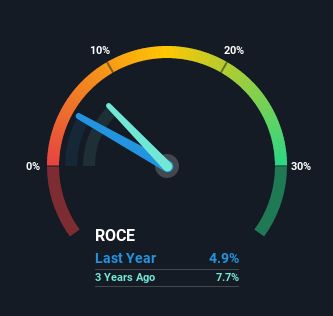- Malaysia
- /
- Trade Distributors
- /
- KLSE:KPSCB
KPS Consortium Berhad (KLSE:KPSCB) Could Be Struggling To Allocate Capital
If you're looking at a mature business that's past the growth phase, what are some of the underlying trends that pop up? A business that's potentially in decline often shows two trends, a return on capital employed (ROCE) that's declining, and a base of capital employed that's also declining. This combination can tell you that not only is the company investing less, it's earning less on what it does invest. In light of that, from a first glance at KPS Consortium Berhad (KLSE:KPSCB), we've spotted some signs that it could be struggling, so let's investigate.
Understanding Return On Capital Employed (ROCE)
If you haven't worked with ROCE before, it measures the 'return' (pre-tax profit) a company generates from capital employed in its business. To calculate this metric for KPS Consortium Berhad, this is the formula:
Return on Capital Employed = Earnings Before Interest and Tax (EBIT) ÷ (Total Assets - Current Liabilities)
0.049 = RM14m ÷ (RM520m - RM227m) (Based on the trailing twelve months to June 2021).
So, KPS Consortium Berhad has an ROCE of 4.9%. In absolute terms, that's a low return and it also under-performs the Trade Distributors industry average of 9.3%.
See our latest analysis for KPS Consortium Berhad

While the past is not representative of the future, it can be helpful to know how a company has performed historically, which is why we have this chart above. If you're interested in investigating KPS Consortium Berhad's past further, check out this free graph of past earnings, revenue and cash flow.
What Does the ROCE Trend For KPS Consortium Berhad Tell Us?
We are a bit worried about the trend of returns on capital at KPS Consortium Berhad. About five years ago, returns on capital were 7.0%, however they're now substantially lower than that as we saw above. And on the capital employed front, the business is utilizing roughly the same amount of capital as it was back then. Companies that exhibit these attributes tend to not be shrinking, but they can be mature and facing pressure on their margins from competition. If these trends continue, we wouldn't expect KPS Consortium Berhad to turn into a multi-bagger.
On a separate but related note, it's important to know that KPS Consortium Berhad has a current liabilities to total assets ratio of 44%, which we'd consider pretty high. This effectively means that suppliers (or short-term creditors) are funding a large portion of the business, so just be aware that this can introduce some elements of risk. Ideally we'd like to see this reduce as that would mean fewer obligations bearing risks.
The Bottom Line On KPS Consortium Berhad's ROCE
In the end, the trend of lower returns on the same amount of capital isn't typically an indication that we're looking at a growth stock. In spite of that, the stock has delivered a 3.5% return to shareholders who held over the last five years. Either way, we aren't huge fans of the current trends and so with that we think you might find better investments elsewhere.
If you'd like to know more about KPS Consortium Berhad, we've spotted 3 warning signs, and 2 of them shouldn't be ignored.
For those who like to invest in solid companies, check out this free list of companies with solid balance sheets and high returns on equity.
Valuation is complex, but we're here to simplify it.
Discover if KPS Consortium Berhad might be undervalued or overvalued with our detailed analysis, featuring fair value estimates, potential risks, dividends, insider trades, and its financial condition.
Access Free AnalysisThis article by Simply Wall St is general in nature. We provide commentary based on historical data and analyst forecasts only using an unbiased methodology and our articles are not intended to be financial advice. It does not constitute a recommendation to buy or sell any stock, and does not take account of your objectives, or your financial situation. We aim to bring you long-term focused analysis driven by fundamental data. Note that our analysis may not factor in the latest price-sensitive company announcements or qualitative material. Simply Wall St has no position in any stocks mentioned.
Have feedback on this article? Concerned about the content? Get in touch with us directly. Alternatively, email editorial-team (at) simplywallst.com.
About KLSE:KPSCB
KPS Consortium Berhad
An investment holding company, engages in the distribution and retail of wooden doors, plywood, and related building materials in Malaysia.
Excellent balance sheet and good value.
Market Insights
Community Narratives



